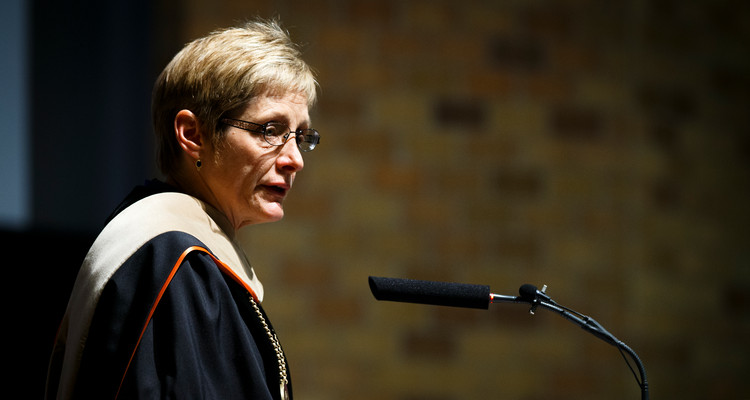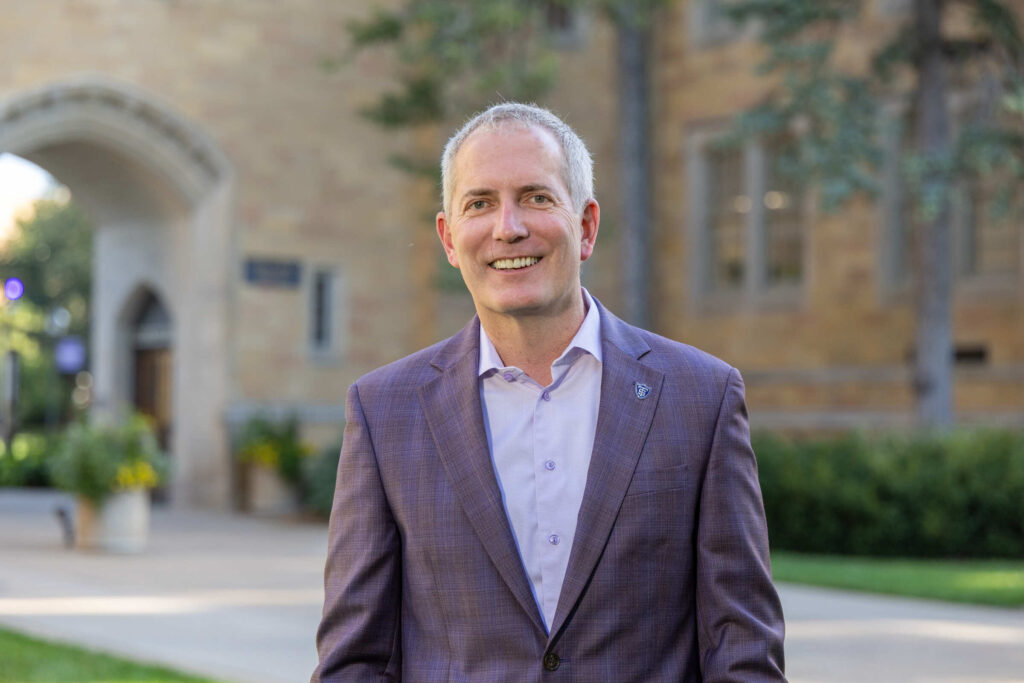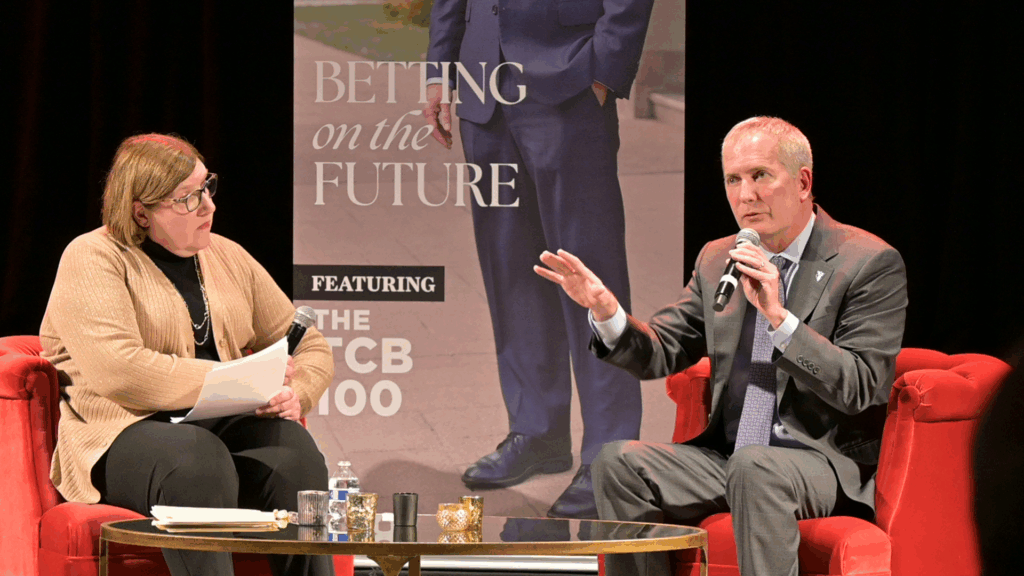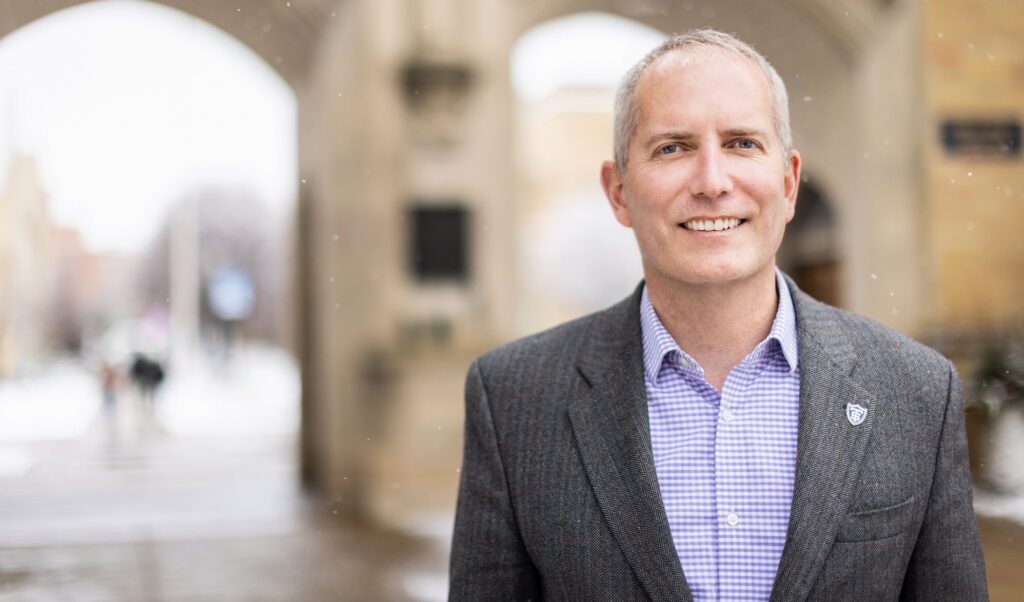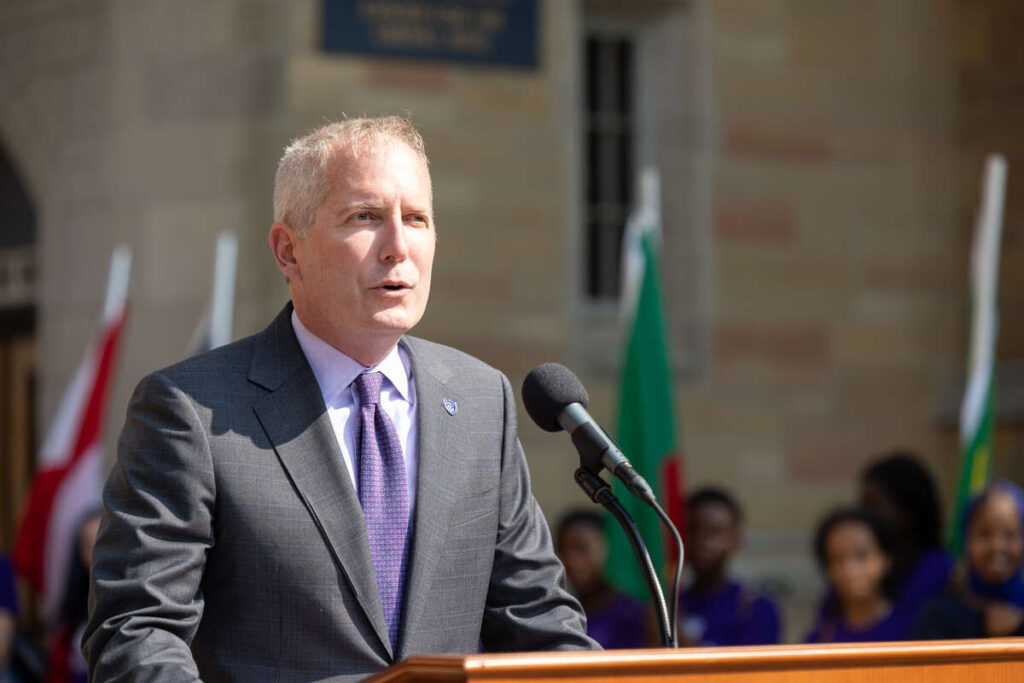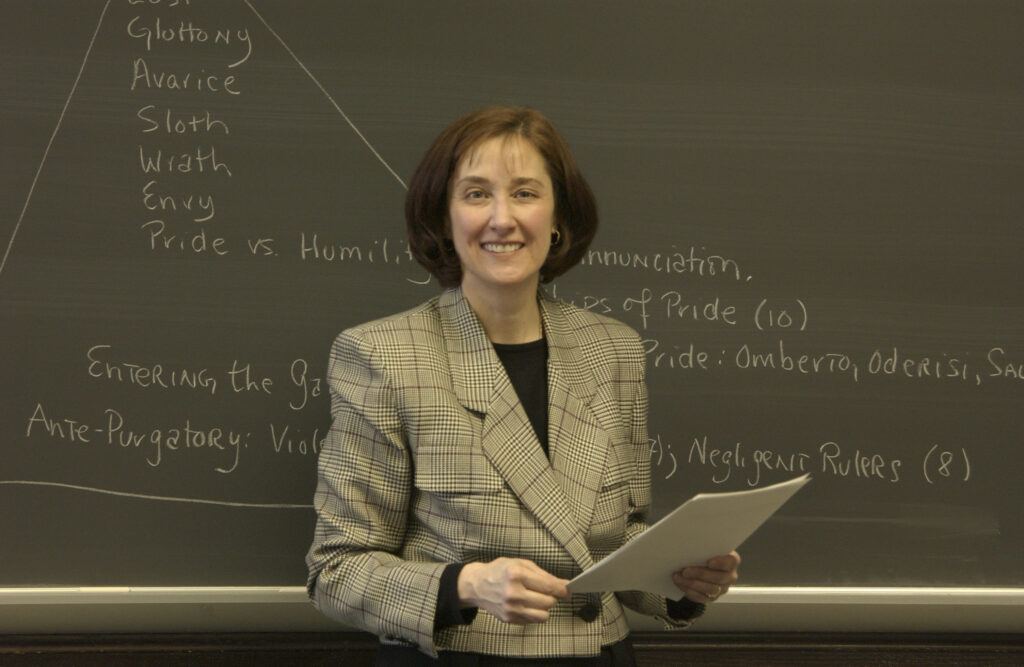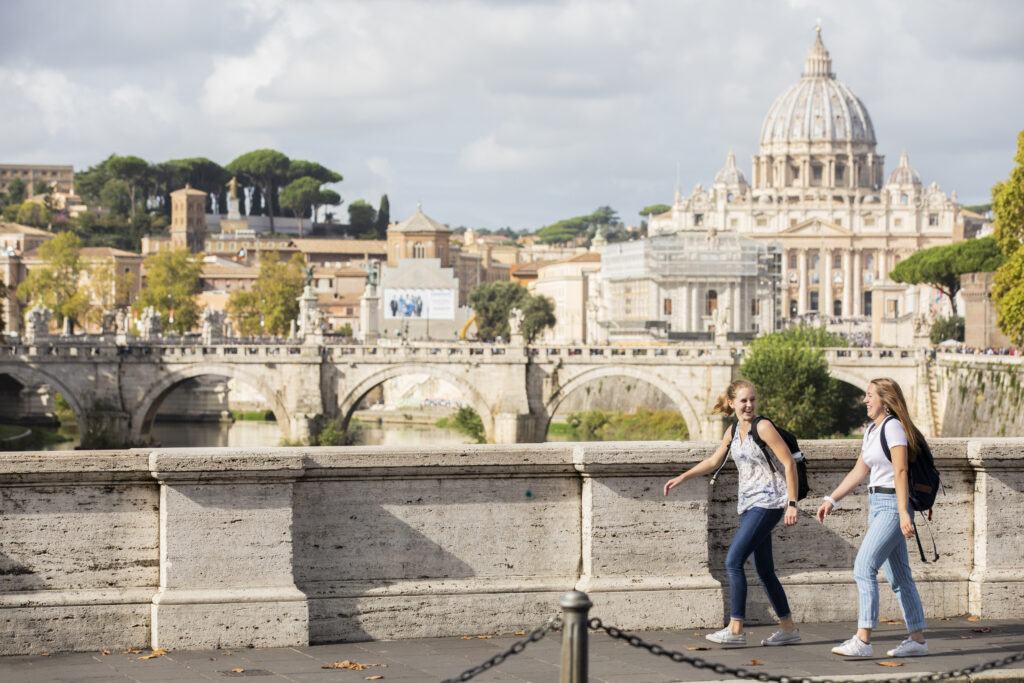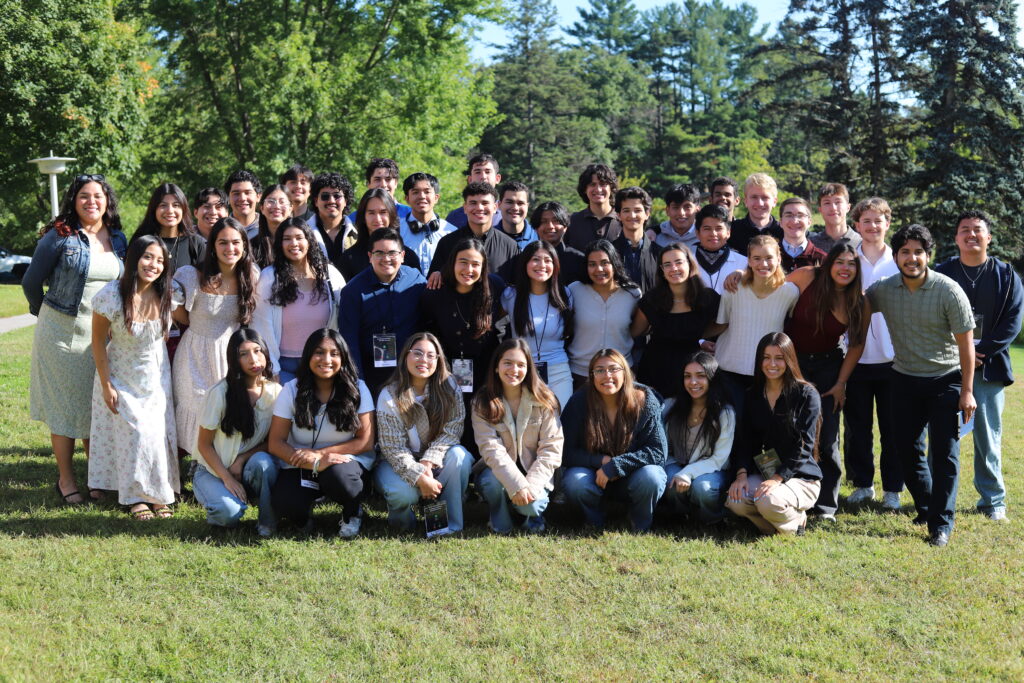President Julie Sullivan urged St. Thomas faculty and staff on Tuesday to join her on an “imaginary exercise” and envision what the university will look like five to 10 years from now.
Sullivan used her annual academic convocation address to offer her interpretation of a working vision statement that has guided strategic planning efforts since last December. She asked questions such as, “How do interdisciplinary inquiry and intercultural understanding contribute to preparing students?” and shared her points of view. Her final question was, “How bold will we be in charting our course towards this vision?”
“In keeping with the inspiration of our founder, Archbishop John Ireland, we must have the courage and conviction to be bold,” she replied. “This is a university that has never been afraid to be bold. We must let this infiltrate us at every level, and we cannot be stymied by ‘fear of failure.’ We must actively nourish and sustain a culture of innovation in everything we do.”
Sullivan then embarked on her “imaginary exercise,” asking the O’Shaughnessy Educational Center auditorium audience to imagine it was watching a slide show as she described images of the St. Thomas of the future. She concluded by again quoting Ireland, who once began a speech wishing he had “the eye of a prophet to see countless generations into the future” but he ended it saying, “But no prophet’s eye is needed, for as we will it, so shall the future be.”
“It is no different today,” Sullivan said. “It is in our hands to create the future that we collectively imagine for St. Thomas, the Twin Cities, our country, and our world ‘For as we will it, so shall the future be.’”
Here is the complete text of Sullivan’s remarks:
Introduction
Good afternoon!
I am delighted to have the opportunity to address you as we embark on the 2014-15 academic year at the University of St. Thomas.
First, I add my greetings and warm welcome to all of those recognized by Provost Plumb and our deans and to all of you who joined us today. I am especially thankful for the presence of our adjunct faculty members. Adjunct faculty have long had a critically important role in educating our students. I am grateful for your dedication and hard work and your decision to work with my administration to better meet your needs and further integrate you into our community.
A year ago, I stood here before you for the first time and recalled how so many people had told me that the university was “poised” to achieve new levels of impact, relevance, and recognition, and I asked you to join me in what I called “our journey.”
One year later, we are on that journey – and we are on it with great resolve and ambition and great opportunity and excitement. We have made significant progress in articulating our vision, and we have embarked on a strategic planning process that has engaged the entire community. Hundreds of you participated in subcommittee meetings and forums, ably led by Drs. Corrine Carvalho and Michael Cogan, and I want to ask them to stand and thank them both for their outstanding leadership of our steering committee and this effort.
A Vision
Last fall, in anticipation of our strategic planning process, we reaffirmed our seven convictions and our strong mission statement grounded in our identity as a Catholic university. While our mission is timeless, we must deliberately review how we make this mission come alive for each new generation of students and concurrently envision what academic excellence means for our ever-changing world. Thus, we developed a new working vision statement that expresses our evolving aspirations, and the strategic plan will plot the course we take to journey towards this vision.
Today, I would like to focus on our vision and the strategic questions that we are wrestling with as we develop the plan for realizing this vision. While our vision statement continues to be tweaked as we move through our strategic planning process, it articulates well the essence of the “star” we are shooting for and reads:
“The University of St. Thomas, a Catholic comprehensive urban university, is known nationally for academic excellence that prepares students for the complexities of the contemporary world. Through disciplinary and interdisciplinary inquiry and deep intercultural understanding, we inspire students to lead, work and serve with the skills and empathy vital to creating a world of greater opportunity, justice, and care.”
Strategic Questions/Considerations
There are a number of strategic questions and considerations the strategic plan must address in charting our course towards the fulfillment of this vision. Many focus on our interpretation of the key words of the vision statement.
• What are the complexities of the contemporary world?
What type of future world are we preparing our graduates for? The one thing I am certain of is that it will be very different from our world today, and it will change at dizzying speeds.
The book The Second Machine Age, by leaders of the MIT Center for Digital Business, provides interesting insights. The authors say we are entering the second machine age of history. The first was ushered in by the Industrial Revolution, and in the second, advances in technology are doing for mental power what the steam engine did for muscle power.
The technologies are not necessarily new, but their power and ubiquitous nature are. Businesses have been using computers for more than 50 years, the PC is 30 and the Internet just turned 20. However, now the power, speed and cost of digital technologies has advanced to the point where we are entering an age when their full force will be achieved. In the next 24 months, this planet will add more computer power than it did in all previous history.
In this Second Machine Age:
- Everything is digitized. Documents, news, music, photos, video, maps and social networks are on demand and at our fingertips, 24 x 7, any time, and any place.
- Everything is connected. Powerful and cheap processors, sensors and transmitters allow the Internet to connect not just people and computers but also things – televisions, thermostats, cars and countless other items. Things constantly measure, sense, and transmit and receive information. It is estimated that 50 billion devices will be connected to the Internet by 2020. And the “internet of things” will mean far more than just remote control of devices from your mobile phone. Just last weekend I was reading about a local company that speculated it could produce a basketball equipped with an inertial measurement unit that connects to the Internet and is sold with a monthly subscription so purchasers can download and see all of the shots they have taken.
- Everybody has access. More people are becoming connected to a common digital network. The World Bank estimates three-quarters of the seven billion people on Earth have access to a mobile phone, and 75 percent of those people are in the developing world. Most soon will have access to smart phones, so it is just a matter of time before everyone is connected to each other and to the digital world. This will bring billions more people into the community of knowledge creators, problem solvers and innovators; billions more people who can work together to better understand and improve our world.
All of this, of course, will cause economic disruption and reallocation of wealth and income. New industries will emerge with huge returns to the innovators who created them, and old sectors will disappear with job loss and dislocation for others.
The nature of work is changing. The U.S. Department of Labor estimates that today’s learner will have 10-14 jobs by the age of 38. Furthermore, the self-employed (freelancers, independent contractors, and temp workers) currently constitute one-third of all U.S. workers and are expected to rise to 40 percent, or 60 million people, by 2020.
The obvious conclusion from this glimpse into the contemporary world we are preparing our graduates for is that we cannot provide a “box” of knowledge with a shelf life of even a few years. We must provide our students foundations of knowledge, learning frameworks and, perhaps most importantly, the skills and capacity for continuous learning and discovery in this constantly changing world.
• What skills are necessary to prepare students for the complexities of the contemporary world?
In a world where information is readily accessible by anyone, it is the wise use of this information that is critical for human flourishing. Skills such as synthesis, analytical and innovative thinking, creative problem solving, and ethical reasoning and action will be increasingly required. In addition, adaptability and flexibility, curiosity, communication, collaboration, initiative, and confidence will be critical. While we have historically labeled many of these as liberal arts skills, they also could be accurately described today as entrepreneurial skills or the characteristics of an entrepreneurial mindset.
Our learning experiences must increasingly focus on developing skills that students need for a lifetime of changing work. Our curriculum will emphasize rigorous and active learning and discovery, appropriate classroom technologies and formats, and partnerships with businesses and agencies for contextual and applied learning. All students must have opportunities to further develop their entrepreneurial and innovative thinking.
• How do interdisciplinary inquiry and intercultural understanding contribute to preparing students for the contemporary world?
The contemporary world is becoming increasingly interconnected. There are fewer and fewer single discipline problems and even fewer single country problems. Our biggest challenges are interdisciplinary and global. We must prepare our students to be connectors, to look beyond boundaries and across silos to find synergies and solutions. We also must prepare our students to engage the world; to be global citizens who effectively make human connections in ways that demonstrate understanding, empathy, and respect.
I expect our curriculum to become more integrated and emphasize interdisciplinary approaches and diverse perspectives. There will be a greater emphasis on multidisciplinary and thematic teaching and research.
• How will our Catholic character be actualized?
We will continue to integrate into our curriculum and co-curricular programs Catholic intellectual tradition and social thought. The university must continue to promote the integration of knowledge; active dialogue between faith and culture; interreligious and ecumenical dialogue; the development of morally responsible persons; and the spiritual formation of all community members.
The fundamental principles of respect for the dignity of all human persons and their unity as part of one human family will animate everything we do on our campus, in our communities, and across the globe. We will demonstrate our ethic of care to all we encounter and in all that we do.
We will build upon our strengths in social entrepreneurship, sustainability, social justice, service learning, and globalization to help students more effectively engage with diverse local and global communities. We will reconfigure a culture of “service” to those deemed “underprivileged” to a culture of collaboration and mutual engagement that transforms all participants and actualizes respect and empathy.
• What does it mean to be comprehensive? How large will we be? What programs will we add? How will we retain focus?
As a result of the leadership and hard work of Father Dease, many others of you in this auditorium, and those who came before you, the College of St. Thomas evolved into a strong, comprehensive university. We have the capacity to revamp and create new areas of study to address current and future societal and workforce needs. We have a rich array of building blocks that can be combined across disciplinary boundaries to create new interdisciplinary programs focused on the needs of tomorrow.
In the spirit of one university, we will eliminate any organizational barriers that inhibit our ability to cooperate and co-create across disciplines and units. We also will choose areas to expand or build upon, such as health care and wellness, where there is growing job demand and we have opportunities to create programs that define outcomes in terms of the dignity of the whole person and principles of integration, efficiency and access.
But we can’t just keep adding programs; we also must be willing to revamp or eliminate programs because we do not intend to grow our residential population to the size of many state and public institutions. For it is both our comprehensive nature and our manageable size that make collaboration so rich and possible at St. Thomas. We must maintain our conviction of personal attention. I have heard from numerous alumni how the personal attention of our faculty and staff inspired them to achieve more and to lead lives of great impact. Thus, I expect our undergraduate population to stay approximately the same or grow gradually and our graduate and on-line populations to grow more rapidly so that we reach and sustain a population of 10,000 to 12,000 full-time equivalent students.
• How do we better leverage our urban location in the Twin Cities?
With our campuses in St. Paul and Minneapolis, we are located in the Twin Cities, one of the most desirable places to live and work in America. We are blessed with a vibrant business community, a strengthening entrepreneurial ecosystem, strong faith communities, creative arts and culture, and many opportunities for recreational and spectator sports. Urban locations historically have been a draw for professional graduate study and are becoming an increasing draw for prospective undergraduate students.
We can provide greater value to and garner greater benefit from this community by forming stronger collaborations and partnerships with organizations in the Twin Cities. For example, we can contribute to narrowing and sustaining the elimination of the achievement gap, as well as enhance our own diversity, by forming more partnerships with schools, churches, and communities of color and underrepresented populations. We can enhance every Tommie’s learning experience by creating more opportunities to learn and work in context of the cities’ robust business organizations. We also can enhance our student life by further connecting students to the cities’ arts, culture, faith, and recreational opportunities. Ultimately, our aim is to identify, recruit, and develop the next creative class of workers and citizens for the Twin Cities.
• What does it mean to be known nationally for academic excellence?
Does this mean we must move to Division I athletics? No. Does this mean we must create more research-based doctoral programs? No. This does mean we want to be more visible to prospective students, high school counselors, alumni, and employers beyond Minnesota and the Upper Midwest. We want our reputation for academic excellence to continue to strengthen and extend beyond these geographic boundaries.
This will require clarifying our messaging to students, employers, alumni, and donors about the value of a St. Thomas education and the value of investing in St. Thomas. We will need to invest in marketing and branding; leverage the energy, enthusiasm, and connections of our 100,000+ living alumni; and expand our resources devoted to student recruiting in strategic national and international locations. This also will require a change in our thinking of who we compare ourselves to for benchmarking purposes. We must consider as our peer schools other similar national universities, such as other comprehensive Catholic universities with national visibility and strong teaching missions.
• How will our student profile change?
As we become better known for academic excellence and the rigor and robustness of our programs, our students’ academic profile will be stronger and their demographics will reflect more diversity, with both becoming more comparable to our benchmark schools. We will be actively committed to attracting the most talented students and increasing the socioeconomic, racial and ethnic diversity of our student body. For undergraduate students, in particular, this will require more applications, lower admit rates or higher selectivity, and strategic use of financial aid. It also will require a five-year enrollment management plan with specific academic and demographic enrollment targets against which we annually measure our progress.
We furthermore must be ardently committed to nourishing and sustaining a vibrant culture of inclusivity leading to consistently high retention and graduation rates across all student demographic groups.
• How can we provide more integrated and flexible pathways into, through and out of St. Thomas in order to become more affordable to a broader range of students and families?
Fluctuations in student demographics and the economic challenges our students face necessitates that we rethink the pathways by which students come to St. Thomas, move through their education, and develop job-related skills. We must provide more flexible and less costly pathways for students to enter our programs, and more flexible delivery of curriculum.
We will partner with high schools and community colleges to provide greater opportunities for students to enter St. Thomas with more earned credits and shorter times to degree completion.
We will provide year-round learning opportunities that allow for accelerated time to degree for our undergraduate and many of our graduate programs.
We will creatively employ technology to expand our access and extend our reach in affordable ways. For example, students might be able to combine work and study over the summer through our on-line offerings.
We will improve our advising and career counseling and expand internship programming, effectively engaging alumni and businesses, especially within the Twin Cities.
• Finally, how bold will we be in charting our course towards this vision?
In keeping with the inspiration of our founder, Archbishop John Ireland, we must have the courage and conviction to be bold. This is a university that has never been afraid to be bold. We must let this infiltrate us at every level, and we cannot be stymied by “fear of failure.” We must actively nourish and sustain a culture of innovation in everything we do.
Imagine St. Thomas of tomorrow
So, as I conclude, please let me indulge myself for a moment and ask you to do an imaginary exercise with me. What will St. Thomas look like 5 to 10 years from today? I am a very visual person, so let’s imagine we are viewing a slide show and I am describing the images as they change. What do I see?
First, I see one university, St. Thomas – Twin Cities, with images of two locations and faculty, staff, and students frequently moving back and forth.
Next slide: a high school counselor is talking to a high school student about applying to St. Thomas and the fabulous experience of other students from this high school who are attending or are alumni of St. Thomas. Wait, this slide is rotating and showing the same scene in different locations – Minneapolis, Chicago, Beijing, Denver, St. Paul, Seattle, Oslo, Boston, and Riyadh.
Next slide: an avatar is approaching both of our Twin Cities’ locations. As she walks onto campus, she sees a diverse and global community of faculty, staff, and students. She sees talented and engaged learners, makers, musicians, and athletes. He has that experience of radical hospitality and feels the energy, warmth, and care. Interestingly, the avatar keeps changing identity and origin, but the experience is the same.
Also, the time of day, day of the week, and season of the year keep changing, but the energy and active living, learning, and creating continues at both campus locations. The buildings are multidisciplinary in scope and multi-purpose, and the people coming and going, whether physically or via technology, include St. Thomas faculty, staff, and students, as well as others from the Twin Cities community and well beyond.
Next slide: It is summer, and a group of students just stepped off an international flight and are approaching both campus locations for a 4-week stay of living and learning with St. Thomas faculty and students and interacting with the business and other organizations in the Twin Cities.
Next slide: It’s a crisp, fall Saturday, and high school students (or are they community college students?) are taking St. Thomas undergraduate courses. Some are sitting in classrooms in Minneapolis and some are connected via technology. Actually, the season just changed; it’s summer, and they are St. Thomas students living and working at home and taking online courses.
Next slide: I see a large gathering of lay and religious persons at our St. Paul location. It looks important. One is wearing a red sash. I see many of our faculty from several disciplines including theology and Catholic Studies, as well as other faculty from around the world, and some of our students. The discussion is lively and animated and I hear words describing important economic, political, and social issues of our time. The frame is changing, and the religious leaders include Catholics and other major religions, and the words relate to peace and understanding.
Next slide: I am leaving my Minneapolis office headed to the airport for several alumni visits. Wait I forgot my passport. It’s in my St. Paul office. As I walk down the corridors, I note the plaques and pictures of recognition and appreciation on the walls. They span our work with Catholic Charities, Catholic Relief Services and Catholic schools, include recognitions by Ashoka and other designations for our leadership in social entrepreneurship, highlight our contributions to eliminating the achievement gap in the Twin Cities, and include awards for the largest number of student start-up companies.
Final slide: As I rush off to the airport, the slide frame expands to include the entire Twin Cities. I see St. Thomas students and alumni everywhere. They are working, serving, learning, and leading in all types of organizations. The frame widens even more and I see Tommies actively creating a world of greater opportunity, justice, and care.
Conclusion
I conclude with a quote from our wise and visionary founder. At the end of the 19th century, Archbishop Ireland was asked to address a meeting of the United States’ bishops on what the future would be like. In his very oratorical style he began, “Oh, for the eye of a prophet to see countless generations into the future…” and he went on and on. But he ended with these simple words: “But no prophet’s eye is needed, for as we will it, so shall the future be.”
It is no different today. It is in our hands to create the future that we collectively imagine for St. Thomas, the Twin Cities, our country, and our world. “For as we will it, so shall the future be.”
God bless you, and godspeed to the University of St. Thomas!
